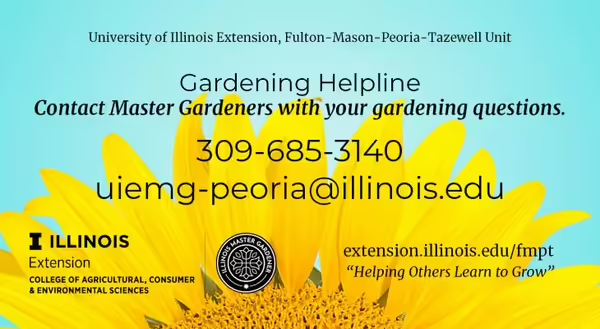
The nationwide Extension Master Gardener (EMG) program began in 1972 when the Washington State Horticulturalist recruited and trained volunteers to help him answer the high volume of calls from the public about gardening. From there the program expanded in scope and grew across the country, but answering the public’s gardening questions is still at the heart of what EMGs do.
Yearly, hundreds of calls and emails come into the “Gardening Helpline” in the Fulton-Mason-Peoria-Tazewell Unit. In 2019, Master Gardeners recorded 160 questions, with tree and shrub problems being the most popular topics. “We know we miss some questions in our tracking system. This year’s number of questions are tracking higher than at the same time last year,” reported Larry Stratton, EMG Helpline project co-leader. During 2020, the Helpline has been handled remotely.
Handling that many inquiries is a large job and could not be successful without the volunteers. Last year, 23 volunteers logged hours handling research, communicating with clients, and sharing information with teammates. EMG Patricia Middleton, co-leads the project with Stratton. A few other EMGs who contributed a substantial number of hours supporting the Helpline included May Bach, Bill Johnson, Rod Skewes, Marth Willi, and Vicki Phillips. New EMG interns are introduced to the Helpline and encouraged to join the team.
Questions about turfgrass, annuals and perennials, garden pests, invasive species, and many other topics pour in. Beyond our four-county unit, Stratton reported questions from 2019 came from 12 additional Illinois counties with a concentration in the Chicago area. With so many non-native plants on the market and now grown in Illinois, answering callers’ questions often becomes an enjoyable challenge for the volunteers. Curiously, calls do come in from far away as well. The most surprising has been calls from California (bananas), Florida (bougainvillea), and Texas (citrus). Local volunteers are able either to answer their questions or direct them to the caller’s local Extension office for help.
Volunteer training is critical to the success of the Helpline. Stratton says “we start by giving an overview of the function and purpose of the Helpline, the kinds of questions we get, how to research for an answer and, a very important part, communication skills with the client.” The Helpline volunteers make use of numerous publications and stay current with emerging horticulture issues.
The Helpline volunteers take a keen interest in the gardening challenges they hear about. Sometimes they chat with callers at length. Stratton recalls that one time a person called about a specific problem, one they solved fairly quickly. The caller went on with the statement "while I have you on the phone…” Stratton said, “Over two hours later and still, on the phone, I felt I had just taken a grand tour of her entire garden. But she was absolutely delightful and it really was one of the happiest calls I had.”
This continuous learning and commitment to gardening of the volunteers, combined with the growing public demand for gardening help, means a great Extension tradition is still going strong.
MEET THE AUTHOR
Anita Wilkinson has been serving University of Illinois Extension since 1998, currently in the role of Communications Program Coordinator for the Fulton-Mason-Peoria-Tazewell Unit. She began her career in Marshall-Putnam counties leading the 4-H program and transferred to Tazewell County 4-H in 2011. Her 4-H experiences began as a youth member and later 4-H volunteer in Stark County where she was born and raised.
ABOUT EXTENSION SNAPSHOTS
Extension Snapshots are monthly impact reports that share the stories of our programs in Fulton, Mason, Peoria, and Tazewell counties. To have them delivered to you directly sign up using our E-blast registration.